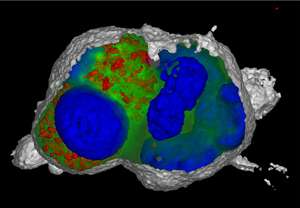Scientists learn to monitor neural stem cells that might help repair neurological damage

A labeling compound identified at A*STAR that specifically marks neuronal stem cells is not only a useful research tool, but could also assist clinical efforts to repair neurological damage in patients.
Even as adults, we retain reservoirs of neural stem cells that can develop into mature replacements for dead or damaged neurons. However, these reserves are relatively small, and insufficient for repairing severe injuries to the brain or spinal cord. Larger numbers of these stem cells could potentially be grown in culture dishes, but to do so researchers would need to be able to separate them from mature, fully developed neurons that are ineffective for tissue repair.
Young-Tae Chang's group at the A*STAR Singapore Bioimaging Consortium is looking for a way "to find and isolate neural stem cells using fluorescent dyes, to then grow them in larger numbers to treat neuronal damage or neurodegenerative diseases."
Chang and Sohail Ahmed of the A*STAR Institute of Medical Biology recently succeeded in identifying such a dye. One of the challenges in cultivating neural stem cells is that although some will divide 'symmetrically' to yield two new stem cells, others divide 'asymmetrically' to produce one stem cell and one mature neuron or glial cells.
Reliably identifying true stem cells with existing dyes has proved challenging to date. "These dyes just diffuse out into both cells," says Chang. He and Ahmed therefore screened a large library of fluorescent chemical compounds in search of a dye that consistently remains stem-cell-specific.
One molecule, which the researchers named CDy5, proved particularly promising. Cultured neural stem cells gradually form structures called neurospheres, composed of both stem cells and neural cells of various stages of maturity. After labeling neurospheres with CDy5, Chang and Ahmed separated out the brightly labeled cells from the dimly labeled ones. Strikingly, cells that were strongly labeled by CDy5 were ten times more likely to form neurospheres (see image). Experiments with single cells showed that this dye remained stem-cell-specific even during asymmetric division, and the researchers subsequently learned that CDy5 forms a strong chemical bond with a protein that is exclusively active in neural stem cells.
Chang intends to use CDy5 to identify culture conditions that either help stem cells maintain their identity or prompt their development into mature nervous tissue. He is also keen to make this tool available to other groups. "I will distribute CDy5 to whoever is interested in using the probe and am excited to see what kinds of new applications or discoveries result," he says.
More information: Yun, S.-W., Leong, C., Bi, X., Ha, H.-H., Yu, Y. H. et al. "A fluorescent probe for imaging symmetric and asymmetric cell division in neurosphere formation." Chemical Communications 50, 7492–7494 (2014). dx.doi.org/10.1039/c4cc02974g
Journal information: Chemical Communications



















